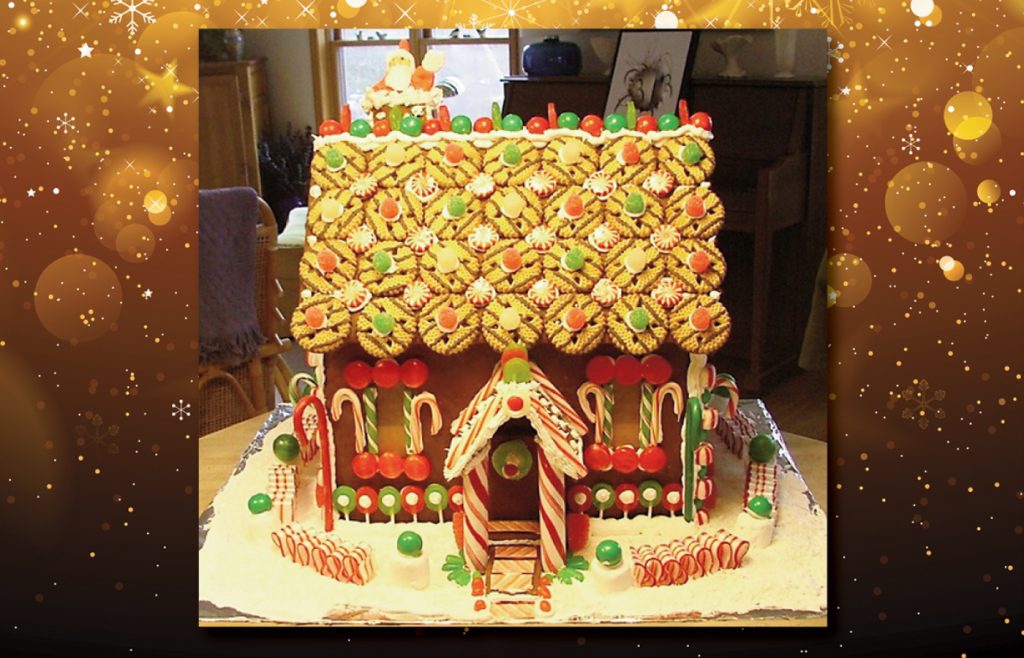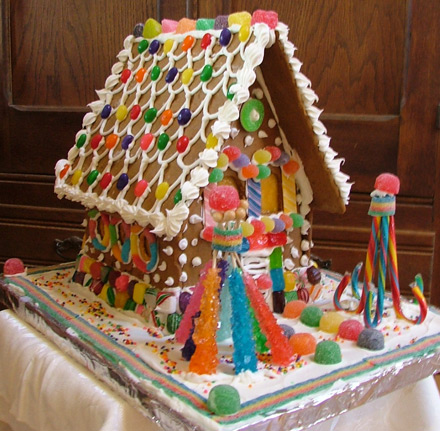
Ever since the Brothers Grimm published the tale of two lost and hungry kids coming across a gingerbread cottage in the woods, families have been building gingerbread houses together during the holidays. If you’ve never made a gingerbread house with your family, why not start a fun new tradition this year?
For expert tips on successful construction and decorating, we talked to gingerbread house-building veteran Holly Moore. She, along with Dawn McKay, was one of the original founders of the annual gingerbread displays at Fairfield’s 1st Fridays Art Walk. Holly has contributed many fabulous gingerbread creations to the annual event, including candy-covered houses to rival the witch’s house in Hansel and Gretel, a scale model of the Eiffel tower, a carousel, and a miniature village.
Structural Support and the Glue that Holds it All Together
If you’ve ever built a gingerbread house only to have the whole thing dry crookedly or even collapse, then these tips are for you.
To start with, you need a sturdy base. For gingerbread structures “basketball size or under,” Holly says a couple of layers of cardboard glued together and covered with foil will get the job done. But for bigger structures, she uses large pieces of plywood, from ¼-inch to ¾-inch thick. A thick cutting board could also work. “A sturdy base is really, really important,” she emphasizes.
Don’t be a purist and insist that your creation must be 100 percent gingerbread. Holly encourages people to get creative and use whatever support structures are needed to give their creations stability. One simple step she recommends is cutting the corners from tissue boxes or other cardboard boxes, leaving the floor. The cardboard corners can then be glued right into the corners of the structure with royal icing.

This gingerbread house uses cookies, candy-covered pretzels, and gumdrops.
Holly also strongly advises against using butter cream icing, because it will melt. The best icing to use when constructing your gingerbread house is royal icing. “Royal icing hardens like cement. When it comes time to throw away [a gingerbread house], I’ve literally had to take a sledge hammer to it because the icing has bonded it like cement.”
Royal icing can be made with egg whites or meringue powder, which can be found at Hobby Lobbys and some Wal-Marts. Children should not be allowed to eat royal icing because it contains raw eggs.
Decorating—The Fun Part!
Holly buys most of her candy, cookies, and other items at “dollar” stores, where it is cheapest, but adds, “gas station candy is often the most unusual and has the best variety.” Unusual candy can even be the inspiration for your gingerbread creation. Holly decided to make a gingerbread carousel after finding animal candies on a stick at TSC.

Candy canes and gumdrops add color to this gingerbread house (by Holly Moore).
The one candy that won’t work well on a gingerbread house is chocolate. Holly says it melts easily and that American chocolate usually contains a lot of lecithin, which means it doesn’t adhere well.
While most of your decorating will be done once the gingerbread house has been assembled and the icing has dried, windows and lighting must be done before building.
Window and door shapes must be cut out before you bake. To create a colorful glass-like effect in the windows, finely crushed lifesavers should be placed in the window holes for the last five minutes of baking the gingerbread. To light up your colorful windows, drill a hole in the platform before assembling the structure and put in some LED lights, which give off very little heat and will not melt your gingerbread creation.

Another gingerbread variation by Holly Moore (photo by Will Merydith).
The Recipes
Here are Holly’s recipes for gingerbread and royal icing. Holly recommends using only the cheapest ingredients you can find, since “these houses are for visual pleasure, not dessert.”
And don’t worry too much about making things perfect, just cover the flaws with royal icing. “It’s very forgiving!” she laughs. “There’s no making mistakes—with enough royal icing any mistake can be corrected.”
Holly’s Gingerbread House Recipe for Light-Colored Gingerbread
1 cup butter at room temperature
1 ¾ cups brown sugar
1 ¼ cup white sugar
2 TBS molasses
6 eggs
6 cups all purpose flour
2 tsp baking soda
1 TBS ground ginger
1 TBS cinnamon
1 TBS allspice (optional)
Baking parchment paper
Cookie sheets
In a large bowl, cream butter and sugars. Beat in molasses and eggs.
In another bowl sift together dry ingredients.
Combine mixtures and knead into a smooth ball. Cover and refrigerate until cool all the way through, several hours. Dough can be kept covered in frig for several days.
Lay out sheets of parchment paper on counter.
Roll out a chunk of dough on parchment paper. Cut into walls, roof, etc., with a knife and remove excess dough, which can be returned to the big ball of dough and reused as you make the house parts. Cut out windows and doors into the dough at this stage.
Left over dough can be rolled out for making extra pieces for the house: fences, trees, steps, etc.
When each house part is ready, slide parchment paper onto a cookie sheet.
Bake at 325 degrees for 15-20 minutes or until slightly firm. Slide parchment paper and cooked gingerbread off onto a flat surface to cool, dry, and harden overnight.
Baked gingerbread walls can be trimmed to make straighter lines with a serrated knife or bread knife by sawing slowly. Use the extra cooked gingerbread to saw out extra pieces you may want: Steps, trees, fences, etc.

Royal icing is the “glue” that holds everything together (by Holly Moore).
Holly’s Dark Molasses Recipe for Gingerbread Houses
5 cups sifted flour
½ tsp salt
1 tsp baking soda
2 tsp ground ginger
½ tsp ground nutmeg
½ tsp ground cloves
1 cup sugar
1 cup butter
1 cup dark unsulfured molasses
Melt butter over stove. In a large bowl, mix butter and sugars. Beat in molasses.
In another bowl sift together dry ingredients.
Combine mixtures and knead into a smooth ball. Cover and refrigerate until cool all the way through, several hours. Dough can be kept covered in the refrigerator for several days.
Lay out sheets of parchment paper on counter.
Roll out a chunk of dough on parchment paper. Cut into walls, roof, etc., with a knife and remove excess dough, which can be returned to a big ball of dough as you make the house parts. Cut out windows and doors into the dough at this stage.
Leftover dough can be rolled out for making extra pieces for fences, trees, steps, etc. after the dough is baked.
Slide parchment paper onto a cookie sheet.
Bake at 325 degrees for 15-20 minutes or until slightly firm. Slide parchment paper and cooked gingerbread off onto a flat surface to cool, dry, and harden overnight.
Cooked gingerbread walls, roof, can be trimmed for straight lines with a serrated knife or bread knife by sawing slowly. Use the extra cooked gingerbread to saw out extra pieces you may want: Steps, trees, fences, etc.
Royal Icing Using Egg Whites
2 large egg whites
3 cups confectioners (powdered or icing) sugar, sifted
Whip with mixer in batches as you go. If you must store, place plastic wrap on it airtight. Icing should be stiff. If not, add more sugar.
Royal Icing Using Meringue Powder
4 cups confectioners’ sugar
3 tablespoons meringue powder
1/2 – 3/4 cup warm water
Whip with mixer in batches as you go. If you must store, place plastic wrap on it airtight. Icing should be stiff. If not, add more sugar.
Royal icing can be applied with pastry gun, knives, spoons, etc. For initial construction of a gingerbread house, prop up walls with canned goods or cardboard as you add icing and it dries. Then remove cans.
Royal icing can be applied with pastry gun, knives, spoons, etc. For initial construction of a gingerbread house, prop up walls with canned goods or cardboard as you add icing and it dries. Then remove cans.
